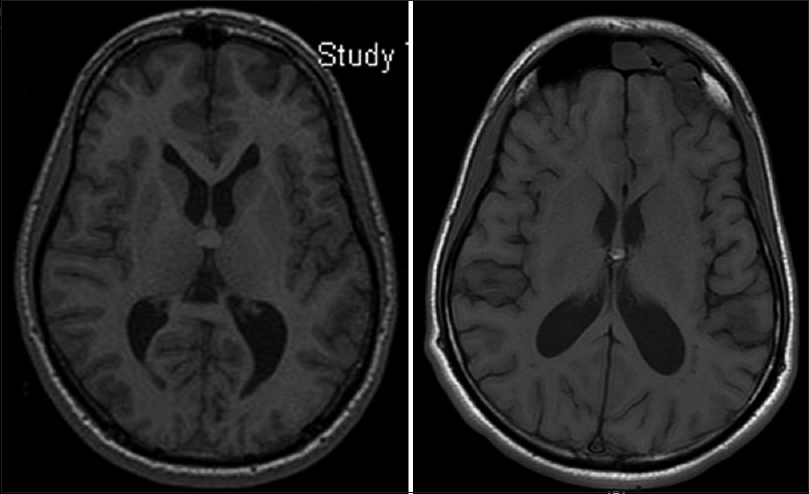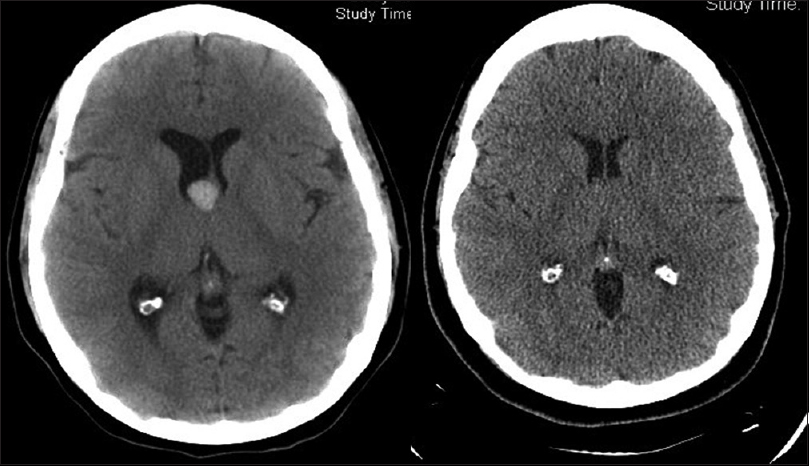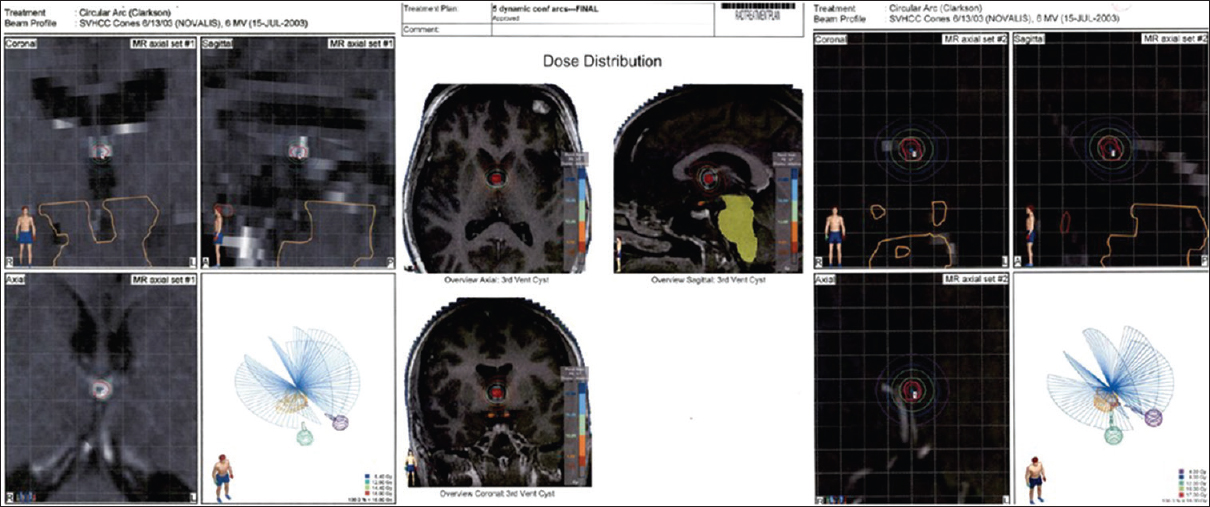- Sanford Research, Sanford Health/USD Sanford School of Medicine, South Dakota, USA
- Sanford Cancer Center, Sanford Health/USD Sanford School of Medicine, South Dakota, USA
- Department of Surgery, Section of Neurosurgery, Sanford Health/USD Sanford School of Medicine, South Dakota, USA
Correspondence Address:
Wilson T. Asfora
Department of Surgery, Section of Neurosurgery, Sanford Health/USD Sanford School of Medicine, South Dakota, USA
DOI:10.4103/sni.sni_180_17
Copyright: © 2018 Surgical Neurology International This is an open access article distributed under the terms of the Creative Commons Attribution-NonCommercial-ShareAlike 3.0 License, which allows others to remix, tweak, and build upon the work non-commercially, as long as the author is credited and the new creations are licensed under the identical terms.How to cite this article: Jeremy P. Morgan, Steven C. McGraw, Wilson T. Asfora. Treatment of colloid cyst of the third ventricle by stereotactic aspiration followed by radiosurgery: Report of four cases. 10-Jan-2018;9:3
How to cite this URL: Jeremy P. Morgan, Steven C. McGraw, Wilson T. Asfora. Treatment of colloid cyst of the third ventricle by stereotactic aspiration followed by radiosurgery: Report of four cases. 10-Jan-2018;9:3. Available from: http://surgicalneurologyint.com/surgicalint-articles/treatment-of-colloid-cyst-of-the-third-ventricle-by-stereotactic-aspiration-followed-by-radiosurgery-report-of-four-cases/
Abstract
Background:Colloid cysts are rare benign lesions with potentially devastating results. Complications intra and posttreatment can result in high rates of recurrence. Stereotactic radiosurgery may present an attractive option for decreasing the rate of recurrence in conjunction with stereotactic aspiration.
Case Description:Here, we report four cases of colloid cyst of the third ventricle managed by stereotactic aspiration with the use of the Leksell frame followed by stereotactic radiosurgery with the BrainLab/Novalis linear accelerator. Follow-up ranged from 7 to 10 years. There were no complications related to the treatment and no recurrence of the cysts, to date. All four patients remain asymptomatic.
Conclusions:The combination of stereotactic aspiration and radiosurgery may have a role in the management of colloid cysts of the third ventricle.
Keywords: Colloid cyst third ventricle, stereotactic aspiration, stereotactic radiosurgery
INTRODUCTION
Colloid cysts of the third ventricle are benign lesions that account for less than 2% of all intracranial tumors.[
CASE REPORTS
Patient #1
A 23-year-old male presented to his primary care provider (PCP) in March 2006 with headaches, blurred vision, and diplopia. A computed tomography (CT) scan indicated mild ventricular dilation and a possible mass lesion in the region of the upper, anterior, third ventricle which was approximately 11 mm in size. A follow-up MRI revealed a hyperintense mass in the region of the foramen of Monro without significant obstructive hydrocephalus suggestive of a colloid cyst of the third ventricle measuring 11.2 mm in diameter. There was additional evidence of a pineal cyst measuring 6.34 mm. The patient was referred to our clinic in regards to operative treatment of the colloid cyst. Stereotactic aspiration of the cyst, followed by radiosurgery a week later was recommended and scheduled.
Accordingly, utilizing the Leksell frame and transaxial MRI scan of the brain without contrast [
The patient initially declined postoperative radiosurgery. Approximately 6 weeks following stereotactic aspiration of the colloid cyst the patient returned for a follow-up MRI. The MRI indicated a colloid cyst in the region of the foramen of Monro now measuring 5.5 mm in greatest diameter. The patient was again consulted by the radiation oncologist for the possibility of undergoing stereotactic radiosurgery for the recurrent cyst, however, he again elected to go home and discuss it with his friends and family before making a final decision.
Approximately 10 weeks following stereotactic aspiration of the colloid cyst the patient elected to undergo stereotactic radiosurgery of the colloid cyst. The patient was subsequently scheduled to undergo stereotactic radiosurgery 14 weeks after the initial aspiration. Previous MRI scans were used for three-dimensional (3D) treatment planning. Treatment was carried out uneventfully with the Novalis LINAC system (Westchester, IL). The head was mobilized by the stereotactic frame. The total prescribed single dose was 18 Gy delivered with a 6-mm collimator and six arcs.
Six months following stereotactic radiosurgery the patient underwent a follow-up MRI [
Patient #2
The second patient was a 50-year-old woman who presented in October 2006 with numbness in her feet and a history of depression. Previous nerve conduction studies were normal. Due to a familial history of multiple sclerosis, an MRI was recommended. The MRI [
Patient #3
A 42-year-old female with a significant history of depression with bipolar disorder initially presented to her family physician with complaints of headache, nausea, and vomiting over 2 weeks in January of 2009. An MRI [
Figure 3
Radiologic images of patient #3. Left: Discovery MR image showing a mass within the anterior third ventricle at the foramen of Monro representative of a colloid cyst. Right: 6-week post-stereotactic aspiration and pre-stereotactic radiosurgery planning T1-weighted MRI demonstrating reduction in ventricle size as well as indicating that the colloid cyst is no longer identified by the imaging study
Patient #4
In June 2009, a 29-year-old female patient presented to her local clinic with complaints of headache, nausea, and vomiting. The patient had experienced migraine headaches since the age of 13. CT scan of the brain [
Two weeks after aspiration, stereotactic radiosurgery was performed. The planning MRI revealed a small somewhat ovoid area of mixed signal intensity seen along the posterior-inferior margin of the septum pellucida in the expected area of the anterior roof of the third ventricle at a level corresponding to the foramen of Monro. These changes correspond with the area of increased attenuation on prior CTs with the size of residual lesion/cavity measuring 8.6 mm cephalo-caudad × 4.7 mm anterior-posterior × 5.7 mm transverse. The target was outlined, the isocenter was identified, and the total prescribed dose of 16 Gy was delivered by means of 7 dynamic arcs in a single fraction utilizing the Novalis micro multileaf collimator for field shape and field blocking. Treatment was uneventful and the patient was discharged in excellent condition. Three months following stereotactic radiosurgery of the colloid cyst lesion, the patient returned for a follow-up MRI (with and without gadolinium) which showed an area of approximately 6 mm of mixed signal at the anterosuperior aspect of the third ventricle in the region of the foramen of Monro. The appearance was not significantly changed from previous exams and there was no increase in fluid content. The most recent axial CT without contrast [
DISCUSSION
Stereotactic aspiration of colloid cyst followed by stereotactic radiosurgery with a LINAC system has been very successful in treating four patients. No recurrence or complication related to stereotactic aspiration or radiosurgery has been observed now at a 10-year follow-up in 2 patients and 7-year follow-up in the other 2 patients. This modality of treatment is certainly attractive considering the duration of the procedures, short hospital stay, rapid recovery, and return to work, as opposed to the multitude of possible complications reported with surgical resection, including loss of short-term memory secondary to fornix injury.[
The partial re-accumulation of the colloid cyst in the first patient is probably secondary to the fact that radiosurgery was only performed 14 weeks following stereotactic aspiration. Following radiosurgery, the tumor size remained stable and the patient is asymptomatic now at 10 years following treatment. The above suggests that, in patients who are asymptomatic but cyst size is enlarging on follow-up radiological investigation, radiosurgery may be an option to arrest growth and prevent symptoms.
The choice of dose was somewhat arbitrary as there was no report regarding the utilization of stereotactic radiosurgery for the treatment of colloid cysts, however, dose prescription was calculated based on the work of Dr. Raymond Kjellberg[
It is unclear as to exactly why the colloid cysts in our patients have not re-occurred. However, radiation is well-known to cause changes in the mucous production of goblet cells, which is likely the mechanism of action. It is also possible that de-vascularization of the cyst or damage to the epithelial cells from the radiosurgery is what prevents fluid re-accumulation. Another issue is the fact that colloid cysts may move according to body position. To minimize this factor all investigations, stereotactic aspiration, and radiosurgery were performed in a supine position with the head mildly flexed. The cyst might be isodense on the CT scan or isointense on T1 and T2 images of the MRI. The flair sequence usually demonstrates the lesion well and we could aspirate the colloid cyst contents in all cases without technical difficulty using a 2.1 Sudan needle and Leksell frame. Likewise, the radiation dose prescribed to the relatively small cyst volume was safe and not associated with any radiation-induced changes to the adjacent neural structures.
CONCLUSION
In conclusion, the combination of stereotactic aspiration and radiosurgery may have a role in the management of colloid cysts of the third ventricle.
Declaration of patient consent
The authors certify that they have obtained all appropriate patient consent forms. In the form the patient has given their consent for their images and other clinical information to be reported in the journal. The patient understands that name and initial will not be published and due efforts will be made to conceal identity, but anonymity cannot be guaranteed.
Financial support and sponsorship
Nil.
Conflicts of interest
There are no conflicts of interest.
References
1. Berger MS, Prados M.editors. Textbook of neuro-oncology. Philadelphia: Elsevier Saunders; 2005. p. 854-
2. Hernesniemi J, Leivo S. Management outcome in third ventricular colloid cysts in a defined population: A series of 40 patients treated mainly by transcallosal microsurgery. Surg Neurol. 1996. 45: 2-14
3. Kahn EA, Thomas CC.editors. Correlative neurosurgery. Springfield, Ill: Thomas; 1969. p. 693-
4. Kjellberg RN, Szikla G.editors. Isoeffective dose parameters for brain necrosis in relation to proton radiosurgical dosimetry. Stereotactic Cerebral Radiation. Amsterdam: Elsevier Press; 1979. p. 157-66
5. Lustgarten L. Is there room for stereotactic radiosurgery as an option for third ventricular colloid cysts in patients refusing surgery?. A case report and some therapeutic considerations. Surg Neurol Int. 2015. 6: S402-5
6. Shaw E, Scott C, Souhami L, Dinapoli R, Kline R, Loeffler J. Single dose radiosurgical treatment of recurrent previously irradiated primary brain tumors and brain metastases: Final report of RTOG protocol 90-05. Int J Radiat Oncol Biol Phys. 2000. 47: 294-8
7. Yenermen MH, Bowerman CI, Haymaker W. Colloid cyst of the third ventricle; a clinical study of 54 cases in the light of previous publications. Acta Neuroveg (Wien). 1958. 17: 211-77
8. Zülch KJ.editors. Brain tumors: Their biology and pathology. Berlin Heidelberg: Springer-Verlag; 1986. p.











